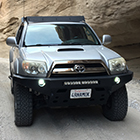 |
Member
|
|
Join Date: Mar 2011
Location: San Diego, CA
Posts: 249
|
|
|
Member
Join Date: Mar 2011
Location: San Diego, CA
Posts: 249
|
If only there was a short, easy, concise answer to give.
You mention a LOT of items you want powered, which complicates any answer even further.
Let's start with the dual battery. The upside of a dual battery system are two fold, one of which is also a downside... The biggest upside is that a second battery can be used to start your engine if your primary/starting battery dies for some reason. The upside/downside is that while you're driving to camp, the vehicle's alternator is charging the second battery. The downside to that is that your vehicle alternator is designed to keep your systems running whilst pouring it's excess into your starting battery keeping it charged. Rarely will a stock alternator do an excellent job when you add extra batteries. Better systems will obviously add a lot of cost to do it right (DC to DC chargers, proper solar setups, etc). The simplest shortest explanation here is this: You will likely never charge your auxiliary battery to the top, which eventually will begin to damage it the more you use it, and you'll be replacing the auxiliary battery much earlier than you expected.
Even upgrading your primary battery to a Group 31 like I have, you will find, as I have, that a daily commute is not enough to keep a beast of a battery like that charged. I never have trouble starting, but I find my battery rests throughout the week between 11.9 to 12.2 volts (an AGM should rest around 13 volts fully charged, essentially meaning at 12.0 volts, my battery storage capacity is at 0, still plenty of energy to start my 4Runner, but if I tried to run my fridge overnight, it probably wouldn't make it through the night) Even after driving many hours, I find that a stock alternator will not charge the battery to full capacity.
However, using my 100 watt solar setup, my 4Runner has sat for 4 days running my engel fridge at 35°, and the battery never dropped below 95% during the nights, and never below 100% during the days. The fridge barely draws 1.5 amps when it's running (30%-40% cycling), and the solar puts in about 6 amps all day long. So long as there's sun, I could probably run my fridge 24/7 without issue if my solar was permanently mounted up top.
The last downside to an auxiliary battery is cost: $250-$400 for the battery alone, around $250 for an isolator setup or around $450 for a DC to DC Charger setup, materials and labor if you have a pro install it; maybe $500.
Now.. For removable/portable batteries, especially ones augmented by solar... I really like the idea of these, even though it's not the route I chose for my setup. But again, your usage is going to determine how big you go here.
What makes these more practical than a battery that stays in your vehicle? You can keep these plugged in to your wall outlet at home, maintaining charge until you're ready to use it. Many of them also offer charging from a cigarette lighter outlet in your car (albeit very slowly! Main purpose here is to keep it charged up while driving to camp before any heavy use begins).
I would not buy any portable battery option if it did not include the ability to charge via solar. Even better if it supports multiple methods to connect the solar panels (Anderson Powerpole, SAE connector, etc) so that I don't have to pay extra for their proprietary panels, I can buy whatever brand I like and get more for it (so long as I don't exceed the input current limitations of the pack's onboard charge controller!!).
I hope this helps, and doesn't leave you more confused. You can find many topics on this on many different sites, with folks arguing one way or the other about which is better.
My personal, and professional (12 volt auto electrical upfitting and specialty systems are the business I work in, building Fire Apparatus, Police cruisers, Surveillance Vans, and Mobile Command vehicles, as well as running Adventure Wired, wiring overlander vehicles) opinion is that onboard systems done correctly can be very costly. Done incorrectly can be downright dangerous and burn vehicles straight to the ground without any warning signs.
If you can find a portable solution that suits your needs and lasts your entire average trip, and DOESN'T require modifying your vehicle at great expense, do it.
__________________
Mitch - Build Thread
Silver '06 4Runner V6 Sport Edition 4WD
Certified Emergency Vehicle Electrical Technician/12 Volt Vehicle Upfitter
Last edited by 4RunAmok; 03-06-2021 at 11:04 PM.
|